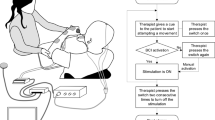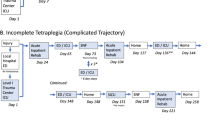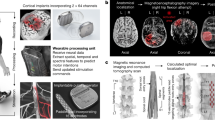Abstract
Study design:
This is a case report.
Objectives:
The objective of this study was to report on a brain–computer interface (BCI) paradigm that is successfully used with an inpatient spinal cord injury patient.
Setting:
This study was conducted in an inpatient rehabilitation hospital.
Methods:
A 25-year-old man with a C5 burst fracture and subsequent tetraplegia (The American Spinal Injury Association) participated in this case study. He completed a brief battery of psychological, pain, cognitive and other screening measures at points before and after the BCI paradigm during his rehabilitation hospitalization.
Results:
The paradigm was easily learned and well tolerated with no adverse effects.
Conclusions:
This case is reflective of the trends in our ongoing feasibility study evaluating BCI technology in the inpatient rehabilitation setting. Clinical implications and challenges of using this technology in a busy hospital unit are reviewed.
Similar content being viewed by others
Log in or create a free account to read this content
Gain free access to this article, as well as selected content from this journal and more on nature.com
or
References
Shih JJ, Krusienski DJ, Wolpaw JR . Brain-computer interfaces in medicine. Mayo Clin Proc 2012; 87: 268–279.
Millan JD, Rupp R, Muller-Putz GR, Murray-Smith R, Giugliemma C, Tangermann M et al. Combining brain-computer interfaces and assistive technologies: state-of-the-art and challenges. Front Neurosci 2010; 4: 10.3389/fnins.2010.00161. eCollection 2010.
Tate DG, Boninger ML, Jackson AB . Future directions for spinal cord injury research: recent developments and model systems contributions. Arch Phys Med Rehabil 2011; 92: 509–515.
Duvinage M, Castermans T, Petieau M, Hoellinger T, Cheron G, Dutoit T . Performance of the emotiv epoc headset for P300-based applications. Biomed Eng Online 2013; 12: 56.
Acknowledgements
The authors wish to acknowledge the Baylor Institute for Rehabilitation Spinal Cord Injury team for their support of this project.
Author information
Authors and Affiliations
Corresponding author
Ethics declarations
Competing interests
The authors declare no conflict of interest.
Rights and permissions
About this article
Cite this article
Salisbury, D., Driver, S. & Parsons, T. Brain–computer interface targeting non-motor functions after spinal cord injury: a case report. Spinal Cord 53 (Suppl 1), S25–S26 (2015). https://doi.org/10.1038/sc.2014.230
Received:
Revised:
Accepted:
Published:
Issue date:
DOI: https://doi.org/10.1038/sc.2014.230



